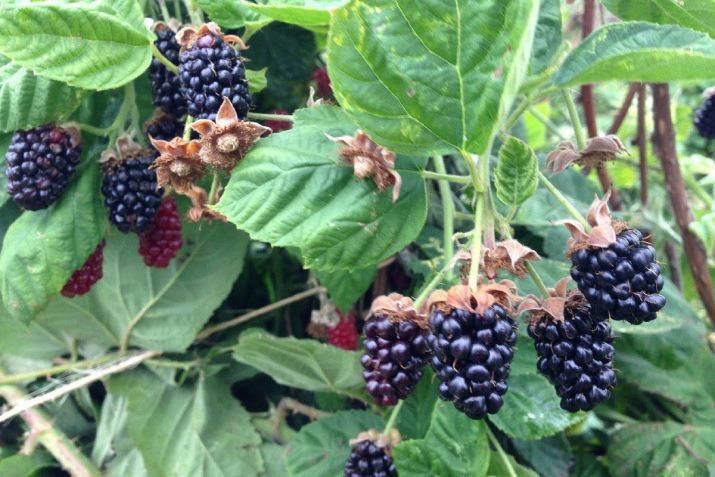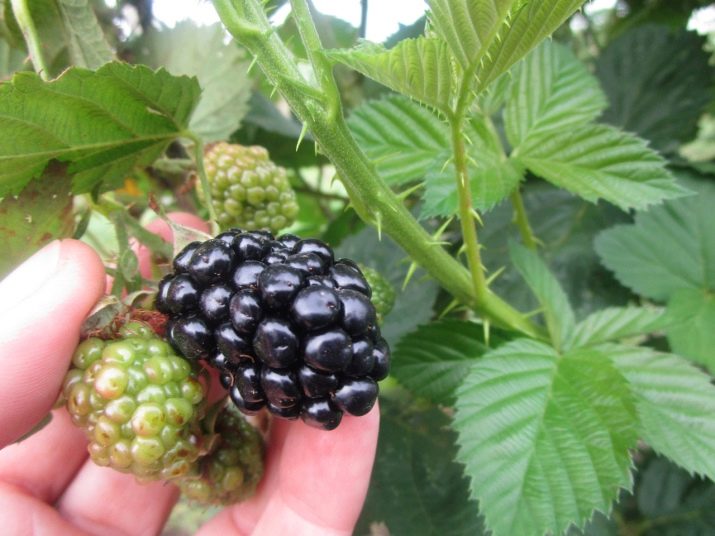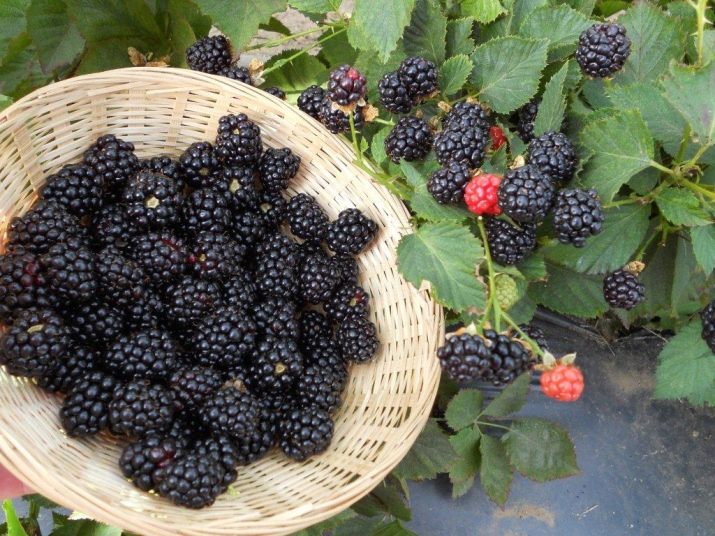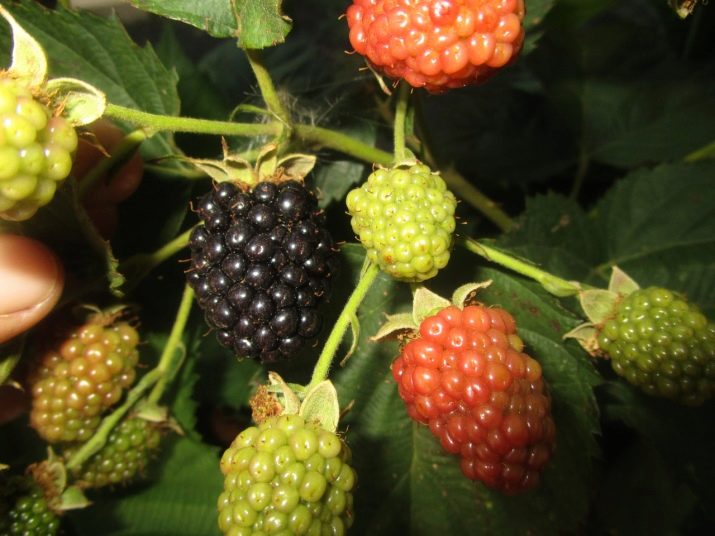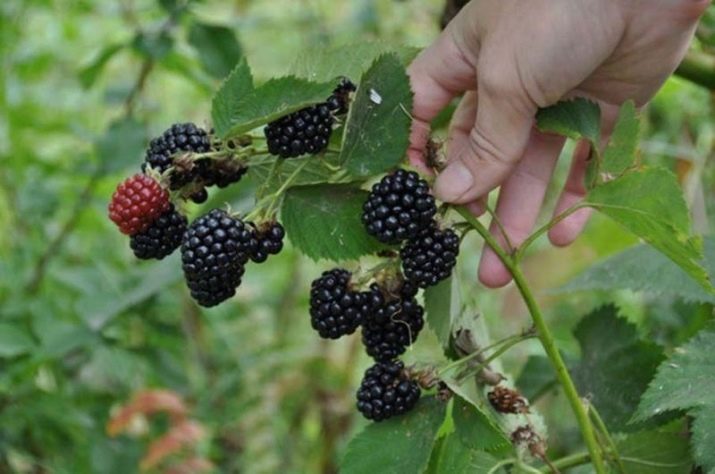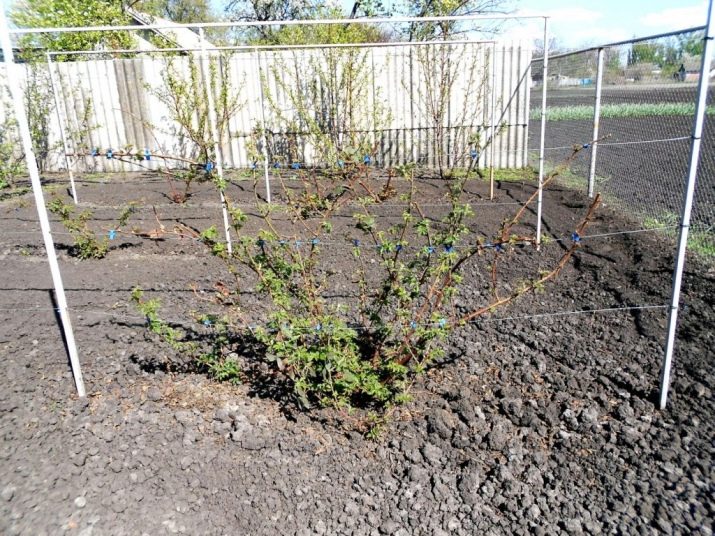Blackberry: description, collection and storage
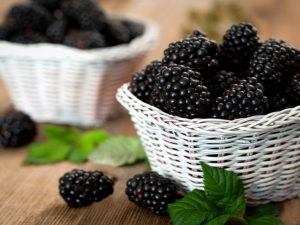
Blackberry belongs to the category of berries, characterized by excellent taste. There are many varieties of this culture.By caring for blackberries properly, you can get a bountiful harvest of fruits, from which you can make tasty and healthy preparations that can make you happy for a whole year.
Description
In the gardens and forests, you can sometimes find interesting multicolored berries, ranging from green to black. This is the blackberry. As it ripens, it changes color, becoming red first, then acquiring a brown tint, and at the end black with a bluish tint. By its structure, these fruits resemble raspberries. This is not surprising. Blackberries with raspberries - berries from the same family.
Depending on the variety, blackberries can be sour or have a sweetish taste. The plant itself looks like a shrub.
Blackberry bush with thorns, so when this plant grows, it forms a "settlement", through which it is very difficult to wade. Most often they are found on the ground cuttings in forests, near streams or rivers.
The blackberry fruit contains important substances for the human body:
- rich set of vitamins;
- trace elements;
- various acids;
- cellulose.
In a positive way, these berries, when consumed, affect the work of the whole organism:
- regulate metabolism;
- strengthen the immune system;
- knock down high temperature, and also treat sore throats;
- useful for digestion;
- effective against kidney and bladder diseases;
- help with diabetes;
- relieve joint inflammation;
- help to overcome gynecological problems;
- Blackberry juice is effective for skin diseases and gum disease.
There are no obvious contraindications to eating blackberry. Some people may be allergic to these fruits. Some may feel something is not immediately, as soon as they swallow a few berries, while others after a day or several, there is swelling of the mucous membranes, diarrhea or vomiting.
Varieties
There are two main types of blackberry - bushy and gray. Gray-blackberry is often called "ozhina" or "azhina." And the first name was adopted in Ukraine, and the second - in the Caucasus. The second name of the bushy - Cumanica.
There are also varieties of garden blackberries. Sometimes a plant with stems that grow straight. This is a cumanica. The variant with the shoots creeping on the ground is called the dewort. There is also a cross between these varieties.
The principal difference between straight-growing blackberry and creeping in that the first is strongly covered with spikes. But in the second the berries themselves are much larger and sweeter. The crop of creeping is noticeably higher and it appears earlier than that of spiny blackberry. Although, on the other hand, the sundew can withstand the cold. Therefore, in the gardens you will not meet it as often as straight-growing bushes.
Where grows in Russia?
There are a large number of varieties of garden blackberries.
- "Tornfri". This hybrid is beneficial because there are no thorns on such plants. Fruits ripen early. Harvest is solid. In the care of the bush is not capricious. You do not have to worry much about how he will endure the harsh Russian winters.
- "Black Satin". Also represents a tall bush without thorns. The height of the plants sometimes reach six meters. The berries are oblong.
- Chester. Gives branched shoots. They grow a lot of sweet berries, having an average size.
- "Polar". Represents a variety with small bushes resistant to frost. Gives a big harvest.
- Navajo. These are plants without thorns of small growth, giving a rich harvest with sweet berries of average size and imperceptible seeds.
- "Triple Crown". Blackberry variety with upright bushes prone to strong growth. Fruits berries of medium size.
- "Kiov". Gives large non-removable berries, convenient to transport. Fruit for a long time.
- "Giant". Blackberry fruits of this variety correspond to its name. Berries, like those of Kiova, appear for a long time. The plant itself is resistant to very low temperatures.
- "Ruben". Berries appear early, but the variety is unstable to frost. During a drought may not bear fruit at all.
- Black Magic. Suitable for Russian climatic conditions. Even in the dry season fruits. The berries in this variety are medium, having an oblong shape. The shelf life is short.
- The Agavam. Variety of American origin. Able to withstand forty-degree frosts. Bushes have large thorns. Fruits of black color have a sweet-sour taste and a pronounced berry smell. From the bush you can get up to four kilograms of the crop. The first ripe berries appear in mid-August.
- Darrow. Upright growing variety. Bushes have straight thorns. They give a big harvest of black and glossy berries of sweet-sour taste. Fruit long. In winter, they endure frosts up to -35 degrees. Today in Russia, the blackberry does not have such popularity as overseas. In the same Mexico, this crop is grown on an industrial scale and supplied to European countries and the United States.
- Wilson Earley. This early variety is a shrub with small spikes, reaching a height of about two meters. The berries are oval-shaped, black with a purple tint. Berries begin to ripen in the middle of summer. This continues until early September.
- "Abundant." This variety is of Russian origin. Brought him Russian biologist and breeder Ivan Michurin. The plant is a creeping bushes with strong thorns, besides bent, which creates difficulties in the maintenance of the culture and the collection of blackberry. This inconvenience is compensated by a rich harvest of large, reaching 10 grams of berries. They have a sweet and sour taste. Mature fruits appear late. The bushes themselves have to cover for the winter.
- "Lucretia". American by birth. It is a creeping bushes with a large number of shoots and thin spines. Winters endures badly. But this blackberry has large fruits that appear early.
In our conditions, it is often possible to find a wild-growing blackberry. And among gardeners, varieties of this crop only gradually become popular. Many believe that in such berries more good than in raspberries, and it tastes better than its cousin.
On our territory, blackberries can be found in the Caucasus, in the middle lane with the most suitable climatic conditions. Sometimes it is planted in Siberia, but for this purpose they choose varieties that are most resistant to frost.
Growing up
Experts advise to plant a blackberry on your site in the spring. May is the most suitable time for this, when there are no longer any frosts. Planted this crop in a site that is well lit by the sun and is not blown by the movement of air.
In the ground under the blackberry should not be long water. It is best if a loam or sandy loaf is chosen for the landing. Back in the fall, the area where the blackberry should settle should be dug up and disinfected on it in order to get rid of other “undesirable tenants” and pests.
For a rich soil in its composition does not need additional fertilizer. If the soil is poor, you can enrich it with organic additives and minerals.
A quality seedling should have well developed roots with stems emerging from it (at least a pair). Also, the plant must be formed kidney.
The size of the pit for planting depends on the dimensions of the planting material. Planted young bushes must be at least a meter away from other plants and various buildings on the site. The distance between the bramble bushes themselves should be about two meters.
Planting a bush, you must do so so that the rhizome was in the hole in the straightened state. Falling asleep deepening nutrient mixture, care should be taken to the kidney at the base of the escape was two centimeters above the ground.
When falling asleep holes should be left under the bush deepening. Water should be generously - four liters of water under a bush. The site must be covered with manure.Having taken all the necessary measures, it remains to cut the stems to 20 centimeters, and remove the fruit buds.
To take care of good growth and cultural development is necessary by installing a trellis, to which the oldest bushes are tied. Young people themselves "grab" for props. For ease of care branches should be sent in the desired direction.
It should be noted that plants with straight bushes do not bear fruit in the first year of life. To wait for the harvest in the second year, all bushes that have grown to a meter will have to be shorter by ten centimeters. Lateral, when reached in height of 50 centimeters, also slightly shortened.
After planting, blackberries should be watered regularly for six weeks. Particular attention to this issue also needs to be paid on hot days and during the ripening of berries. Watering is carried out by separated or rain water. Cold water can not be watered.
The area on which the blackberry is growing should be well maintained. Weeds are not allowed on it. Land need to loosen. If this is difficult to do, you can cover the soil around the bushes with straw.
As for fertilizers, nitrogen fertilizing is done during the period of green growth on the bushes. Suitable urea or organic fertilizer. A “square” will require only 20 grams of urea, and organics - 4 kg.
Every year, the land must be enriched with potassium in the amount of 40 g per m2. However, it is important that the additive does not contain chlorine.
Blackberry trimming is not a one-time procedure. In the spring, the bushes should be trimmed before fluid begins to move and the buds begin to swell. In the process of such work it is necessary to break out the dry and frost-affected specimens.
Pruning young bushes activates their growth. To do this, this procedure is carried out in May, shortening the blackberry by five centimeters. As plants grow, they produce lateral processes. 7-8 of the strongest must be left, and the rest removed altogether.
In winter, if the temperature does not fall below ten degrees (with minus), the blackberry can be left as it is. If the winters are frosty, it is better to cover it. For these purposes, hay is most often used. The supports under the bushes need to be removed, the branches should be bent down to the ground and covered with dried grass. Then close the entire area with an oilcloth or other covering material.
It is possible to propagate the blackberry using otvodok (those plants that spread). Upright breeding cuttings or division of the bushes.
The easiest way to reproduce it is layings. The branch bends towards the ground and is covered with earth. The roots on the newly appeared bush appear quickly. After that, it remains to carefully separate the new blackberry from the mother plant.
It is possible to fill the whole branch with soil at all. Then several bushes are formed at once. They can be seated so that the necessary distance from the “neighbors” is observed. The best time for such procedures is spring.
If the plant in the spring does not give new stems, you can divide the roots into pieces that can take root. This is the division of the bush.
Valuable blackberry varieties propagate by cuttings. In early June, from the top shoots take pieces of branches with buds and leaves. The incision site is treated with a special compound that promotes the appearance of the roots, planted cuttings in a pot with a mixture of peat and sand.
In order for a reliable root to emerge, the cuttings must be kept in a moist environment. Therefore, they are placed in a greenhouse. A month later, the young plants are transplanted into the open ground.
Growing blackberries sometimes requires dealing with various diseases that bushes are exposed to.
With excessive fluid, especially in the period of prolonged rains, anthracnose may develop. Externally, this is manifested in the formation of purple spots and ulcers. In winter, these stems die. In order to prevent this disease, you need to remove weeds from the site in time and cover the ground with manure. For treatment, fungicides are used, in particular, Bordeaux mixture.
Another blackberry attack is Didimella. As a result of the disease, the leaves of the plants dry up, the buds die, and eventually it happens to the whole shrub.To catch the onset of the disease can be on such grounds as changing the color of the leaves from green to brown with a purple tinge.
The buds become black as the disease progresses, and the leaves are spotty, broken and dry. It is possible to prevent the development of such a disease by introducing fertilizers in time and by treating the kidneys with Bordeaux mixture.
Gray rot on the berries - botrytis. To prevent the destruction of the crop can only be one way - do not allow the bushes to grow. Fresh air does not pass through such a density and the fruits are damp, becoming covered with rotten bloom.
The most common disease for blackberries is powdery mildew. It can be removed with the help of preparations containing copper.
Also note that ticks, weevils, aphids, and caterpillars can attack blackberries. In order not to lose the bushes and the crop, the plants are treated with insecticides.
When and how to pick berries?
Depending on the variety of blackberries, her berries become mature either in August or in September. If we are talking about collecting wild berries, you need to clarify the time of ripening in a particular area.
For the collection should not choose a place near the road - road and rail. Dust and soot that fly around, densely deposited in the berries of blackberry.
It is better to go to the forest edge or look for a place near the country road. It is important to make sure that no one is spraying toxic chemicals near the selected area.
It is advisable to pick berries in the morning after dew or after rain. Then there is the confidence that there is no dust on the fruits.
When searching for wild blackberry growing areas, you need to pay attention to the dense dark green thickets with red stems. Such usually happen on the open areas where there is a lot of light and moisture easily enters.
Going for the berries, you need to wear clothes that will not let the thorns of plants to the skin. For example, you can choose a long-sleeved hike for a hike. It is useful and mosquito repellent and sunblock, as well as a wide-brimmed hat, in order to avoid the negative effects of the sun.
In order to fold the berries, you can take any lightweight deep container. For example, a bucket. To make it easier to move, you can hang the container on the belt by the handle, or just hold the container in one hand and collect the fruits with the other.
One should not neglect such a thing as a stick or cane. It is advisable to use it in the bushes before moving into this thicket. There may be snakes and other unsafe living creatures. You also need to carefully look at whether there is a nearby wasp nest, plants burning with poison, or ants.
Collecting blackberries, you should take such berries that have finally ripened, but did not manage to curl. The best fruits are hard and black with a reddish tint. Collecting blackberries one by one, you can put them in the palm, and only when it is full, pour into the container. Thus, it is not necessary to spend time on putting each individual berry there.
On the way from the forest, the collected berries should not be shaken too much, otherwise they will give juice.
Before using or further processing the berries should be washed. It is therefore very important in the collection process not to crush the fruit.
To wash the berries, you need to put them in a large container and slowly pour water into it to completely cover all the fruits. They will begin to rise to the surface. In the tank you need to gently move the liquid so that all the garbage and dirt will rise to the top. Rinse the blackberry should be immediately before you carry out with it any action. If you wash it in advance, it may have time to become moldy.
How to store?
Blackberries, like raspberry fresh, are a perishable product. Fresh it can be stored in a refrigerated cabinet for only four days. Further the harvest will sour or mold will kill it.
It is better to eat crumpled berry immediately after harvest. It will still be spoiled even with a short storage time.
A fresh berry will last longer if scattered in the cold in a thin layer, spreading a napkin on the plane where it is located. The paper will absorb excess liquid and will not allow the berries to quickly turn sour.
Washed blackberries with sugar can preserve the freshness and nutrients of days 20, if kept at a temperature of 0 degrees.
A good way to save a crop is to freeze it. Due to this, almost all valuable substances and its taste will be preserved in the blackberry.
For such a method of preserving the product, you can use quick freeze. The berries are laid out in a single layer on a flat surface. This can be a tray, baking sheet, cutting board and the like. This item should be placed in the freezer. It is placed in the chamber at the lowest temperature.
An hour and a half later, the frozen blackberry is shifted into convenient containers or laid out in packages. Put in such a container in the freezer for long-term storage.
The convenience of this approach is that each berry remains separate. It is easy to pour it for any needs in the required quantity. Defrost such a product at room temperature, and in a hurry - in the microwave. You can also soften it with hot water.
You can simplify the freezing process. In this case, the blackberry is laid out in small portions in separate packets of polyethylene and sent to the chamber. It is advisable to put as many blackberries in a container as possible at the same time.
Packages with blackberries should lie in the freezer at least a day. After that, you can check how much it is frozen. To do this, simply pull a berry out of the bag and evaluate its condition.
Shake the bag with frozen fruits so that the contents disintegrate into separate parts. Without loss of beneficial properties, this product can be stored frozen for a year.
In order to save the blackberry, it can be dried. In this form, it will be able to save as much as two years. So that it does not lose all its beneficial properties and does not lose its taste, you need to keep in mind the following.
- It is necessary to take only fully ripened fruits for drying.
- Before starting the process, hold the product in the sun for two or three days, laying it out on a plane with a thin layer and isolating it with a loose insect cloth.
- After this, dried fruits are finally dried in the oven. To begin with, the temperature in it is set at 70 degrees, and a couple of hours before the process is completed - at 45-50. The oven door needs to be kept slightly ajar.
It usually takes about five hours to dry a blackberry in the oven. The prepared product is securely packaged and stored in a cool, dry and dark place.
Another way to store blackberries is with shabby sugar. The method is interesting because there is no processing of the product at a high temperature, thereby retaining most of the useful substances in it. In addition, for this preparation, you can take crumpled berries. The only important thing is that there are no signs of mold on it.
To do this, the blackberry should be washed and dried on paper that absorbs moisture well. Prepared berry spread in a comfortable bowl deep and pour sugar at the rate of one to one. Although sugar can be taken more.
The contents of the pelvis remains mixed and grind. To do this, you can use tolkushku from the tree. You can also use any kitchen grinder.
After completing the procedure, the mixture is left for half a day in a cool place so that the sugar finally dissolves in the berry mass.
Now you need to once again stir and distribute the wiped blackberry into separate well-washed jars. They can roll up under the metal covers. It is necessary to store the billet in the refrigerator or in the underground for a year or a little longer.
Some of the berries can be turned into jam, which is later conveniently used as a filling for pies and for making other desserts for tea. For two or three glasses of blackberry you need to take 200-300 grams of sugar and a tablespoon of lemon juice.
Washed berry should be left for some time to dry. Then put it in a deep bowl and crush. The easiest way to do this is to take a spoon. When the juice stands out, pour sugar, lemon juice into the dishes and leave it for three hours to infuse the mixture.
Pour half a glass of water into the pan and put it on the hob. Put the blackberry in the sugar and, stirring slowly, bring to the boil. Cook on low heat for about 15 minutes, not more.
In the process of cooking the foam should be removed so that its presence does not affect the final taste. When the jam becomes uniform and thick, it can be distributed in sterilized jars, rolled up under the lid and wait for it to cool.
After that, the product can be stored in a cold place. If pectin or gelatin is added to the jam, it can be stored for a long time even at normal household temperature.
The product with pectin turns into marmalade. To save the blackberry in the form of such a dessert, you need to take 1 kg of blackberry puree, a pound of sugar and 40 grams of pectin powder plus 4 grams of citric acid.
Prepare the fruit should be the same as before cooking the jam, then pour the berry puree in a wide saucepan, add a few spoons of water, cook. Then hold the composition on low heat so that a significant portion of the liquid evaporates. The entire volume should be reduced by one third. Add a quarter of the required amount of sweet sand, cook for five minutes.
Pectin powder mixed with powdered sugar on the basis that for 40 grams of pectin there are 200 grams of powder. Add to total weight. When the sweet pectin is dissolved, you can enter the remaining sugar. The mass should not stop boiling. Continue cooking. At the end add citric acid dissolved in water in a spoon.
Remove the foam, and the marmalade, which has just boiled, decomposed into pre-prepared jars. Roll up under the covers, put the bottom up and wait for the banks to cool.
The marmalade on gelatin is hard and useful in its content. In order to store a blackberry in it, you need to take:
- 1 kg of berries;
- as much sugar;
- 60-80 grams of gelatin;
- molds for segments.
Prepare the berry as for the previous storage options: rinse and let go of the water. In the course you can start up and crushed, and overripe, but high-quality fruit. They are laid out in a pan (preferably with enamel). Pour a glass of water, and then place two glasses of sweet sand in a container. So leave the product for a couple of hours, so that it sugared.
Place the pot on the stove and let it boil gradually. In the process you need to mix the blackberries in the sugar with a wooden spoon. When you get a thick syrup, remove the container from the stove and strain what it has, through a sieve with small holes. This way you can get rid of the seeds.
All valuables must be returned to the pot, and then to the stove. Ten minutes to hold on the lowest heat, gradually adding the remaining sugar. Then add gelatin and how to mix. After that, turn on the stove and after a minute or two remove the fire, allowing the future marmalade to cool.
After that, you can pour the contents into molds and put them in the fridge so that the marmalade grabs finally. If, after distribution into the molds, the marmalade is still in the pan, it can be put in small jars and rolled up. In this way, you can stretch the pleasure of eating dessert to tea for months.
A good way to store blackberries is in the form of compote for the winter.
Berries need to be cleared of visible debris and rinsed. To get at least two liter cans of compote, you need to take:
- 700 grams of blackberry;
- 1.5 liters of water;
- 300 grams of sugar.
Banks and lids sterilized. Put berries in them, sprinkled with sweet sand. Pour the same water (cold).
Close the containers with lids and put in a spacious pan, in which not too hot water is added (banks may burst from boiling water).
After boiling water, sterilize them for 10 minutes.Then roll up the jars, turn them over and wrap them in a blanket, wait for them to cool.
On a larger volume of berries can be done differently. For five liters of billet, you will need:
- 3 kg of blackberry;
- 750 grams of granulated sugar;
- 1.5 liters of water.
Berry to sort and rinse. Sterilize jars and lids. Make a syrup from sugar and water. When he starts to boil, distribute the berries in the container, and then pour boiling sweet liquid into them.
Put the lids on the jars and sterilize at 80 degrees for ten minutes after the water begins to boil. Then the container securely clog, turn and close the blanket. Remove to storage when it gradually cools down.
Reviews
Reviews about blackberries are mostly positive. Many note its unusual taste and the fact that it is very interesting to use such a berry in desserts. It makes excellent jam. It looks great on the cake and complements its taste.
According to gardeners, it is much more profitable to plant blackberries on your plot, rather than gathering wild ones. The forest berries are small, but domestic crops have fleshy, large fruits that are easy to handle.
There is always a dispute between people about whether it tastes better - blackberries or raspberries. Proponents of raspberries, traditional for Russia, believe that its taste and aroma are more pronounced, others object that it is necessary to select the best blackberries for planting, then it will not disappoint. Many people note the taste qualities of the berries of the varieties Agave, Ruben, Black Magic and Tornfri.
For experienced gardeners it is also important how convenient the blackberry of one sort or another is to maintain. Resistance to frost and lack of thorns are of great importance.
How blackberry matures, you will learn from the video below.











